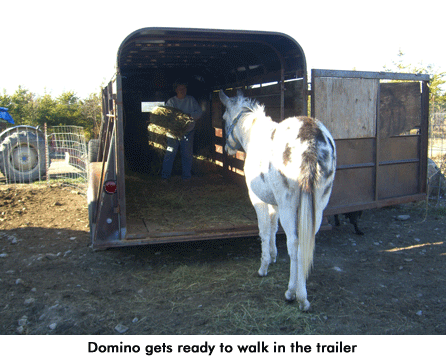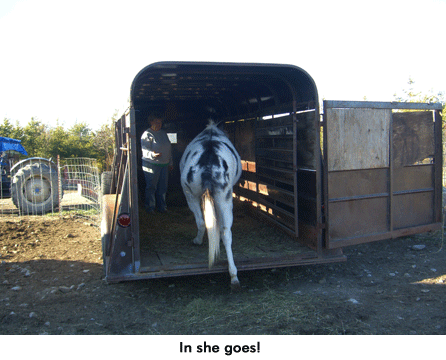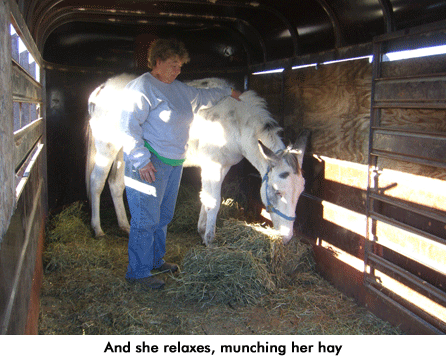When I bought our weanling mule, Domino, she was as wild as a deer. She’d never been touched by human hands. Thus, she was pretty skittery. I worked with her all last winter and this summer, gaining her confidence. First all I could do was to touch her, then scratch her, working all over her body. Then came trying to get a halter on her…without frightening her. It took weeks, but it was finally accomplished. Tying came next. I fastened a rope to a post in her stall, then while I was feeding her in there, I quietly snapped the tie rope to her halter. Because it’s a small stall, she couldn’t fight the rope much…and she didn’t really even try. Soon she accepted being tied and cross-tied with no fuss. Plenty of neck scratching and a few horse treats and she was fine. Then came leading. Because she was so big by then, I couldn’t do the old butt rope trick I use on foals; she was too strong and would break away from me. I don’t ever like a horse (or mule) to learn they can yank away from me; it’s a bad habit that can cause trouble later on. So, again, very slowly, I’d just take her halter in my hand and urge her forward. She’d been tied regularly and knew not to fight. If she got frightened, I’d just let her go and not try to hold the halter; she’d come right back and we’d get back to lessons. First it was only a step forward, then two. Finally, she was leading several steps easily and learning what “Come here,” meant. Then I snapped her lead rope on and we started doing laps around the corral. No problems. One time, a turkey flew up over the barn and she spooked. Luckily, I could hold her and she settled right down. I felt pretty good about that!
We want to move her down to the horse pasture, about 700 feet from the barn. Yes, she leads. But she’d have to pass our husky pen, a travel trailer, and the training ring. And I don’t know if I could hold her if she REALLY spooked. So instead of a fight, we decided to teach her to load in the trailer and drive her down to the pasture. Will backed the trailer into her corral and unhooked it. We then let Domino out of her stall and I got some hay and put it in the front of the trailer. Was she frightened? Not much! In fact, when I called to her from in the trailer, she took a step up and walked right in. Wow, was I impressed! A lot of older horses that have loaded still wince and spook when the trailer bangs under their feet. Our yearling mule didn’t bat an eye! I’m convinced slow, patient training pays big dividends in the long run.
Readers’ Questions:
Canning bamboo shoots
Picked up some gallon cans of bamboo shoots and want to know if you or anyone else has recanned them in smaller jars,1/2 pints?
Pat Kaufman
Seymour, Missouri
No I haven’t, nor could I find a processing time for them anywhere. Any readers out there who HAVE found a safe processing time for bamboo shoots? — Jackie
Rhubarb pie filling
Just read your recipe for rhubarb pie filling and I’ve got a couple of questions…Is the stated processing time for pint or quart jars? And then how do you use the filling for pies? Just pour a jar in the shell and bake? A pint jar or a quart jar? Oh, and a guesstimate on how many pints or quarts this recipe makes, so I can have something like enough jars and lids ready! ‘Cause I am definitely making some of this up next spring!
Jane Jasper
Sapello, New Mexico
I couldn’t find a recipe in my canning book for rhubarb pie filling. Did you mean the rhubarb pie recipe on page 222? This makes one pie. It takes a quart of canned, drained rhubarb. — Jackie
Storage potatoes
Thank you for your advice on the best storage onions; it is very helpful. I bought some copra seeds, which sprouted beautifully and have been transplanted into my winter garden and are loving being there. I hope they do well here, even though they are more for northern (long-day) climates. It seems like you have talked about the best storage potatoes before as well, but I’ve searched your blog and the magazine’s website for this information and have not been able to find any recommendations. What are your recommended or preferred storage potatoes for longer-term keeping? Are most brown potatoes better keepers than red, yellow or purple potatoes?
Dallen Timothy
Gilbert, Arizona
While reds will store a long time, I have had better luck with Russets and Yukon Gold. If you have good storage facilities, nearly all potatoes will store well into the following spring. We used to store in a heated — although not warm — basement; now we store in an unheated basement, kept around 40 degrees all winter. Our potatoes LOVE that. We were still eating old potatoes that were crisp and hardly sprouted when we were bringing in our NEW fall crop in September! — Jackie
Storing beans
I’ve been growing beans in my garden. I planted them next to the corn and they grew up the corn stalks “Squanto Style.” I’ve now been harvesting the beans and putting them in a plastic bag. Yesterday I realized that there was mold on the beans and I’ve lost about half the crop. What can I do to better store harvested beans?
Carl Robinson
Chesterfield, Virginia
I would either can or freeze your beans. You can store them in a bowl, in the refrigerator, for a few days, but like anything else, the fresher your beans are — to can, to freeze, or to eat — the better they’ll taste. Sorry you lost those beans. I really hate when something like that happens to me! — Jackie
Canning tomatoes
I have just finished canning my first batch of tomatoes and I don’t feel confident about some jars. I did a water bath for 40 minutes, and added lemon juice but one of my jars was over full,leaking juice after the boil so I took the lid off, took some juice out, put the lid back on with the intent to reboil the jar but it soon sealed any way! Is this a for sure sign it is safe? I also have some jars that have air bubbles, is this normal?
Kenneth Daugherty
Craig, Alaska
I wouldn’t count on the seal on the jar that you took the juice out of; refrigerate that one and use it fairly soon. If a jar is blowing liquid out, just leave it alone. It will probably seal unless bits of food have gotten under the lid rim. Don’t worry about the air bubbles; this IS normal. After you get a little more canning under your belt, you’ll relax a lot more and get the hang of things. Keep at it! You’ll be an “old pro” real soon. — Jackie
Shower cleaning spray
I’m wondering if you know of a recipe to make a Shower Cleaning Spray. Like the ones you can buy and spray after showers to keep the spots down.
I’m thinking that maybe something simple could work like using a little bit of a Dishwasher Rinse Agent in some distilled water…then spray it after the shower? Any ideas? My goal is to be able to live here comfortably without more than a few trips to town a month.
Joe Hindman
St. Johns, Arizona
You might try plain old white vinegar. It works quite well on scum and doesn’t leave spots. I sure understand your reluctance to go to town. I really hate shopping! — Jackie
Stew in a jar
I want to try this but would like your thoughts.
Take a quart jar fill the bottom 2/3’s with potatoes, onions, carrots, parsnip, then put boiling water, next finish filling with deer meat.
This would all be raw pack and then into the pressure cooker for 90 min’s.
Stew in a jar quick and easy.
Dan
Shawnigan Lk, BC Canada
I can’t see why this wouldn’t work, Dan. And it should be tasty, too. — Jackie
Scab on potatoes
We really love our Yukon Gold potatoes, but have a lot of trouble with scab. We grow them the usual way, just buried in the dirt. Do you have any suggestions that might help, or do I need to grow a different type of spud ? Also, with your experience living in the mountains, can you recommend the best seed varieties for short growing seasons?
Robin Balczewski
Colville, Washington
You usually get scab from using plenty of manure to fertilize your garden; we are bothered by scab too. To lessen this problem in our Yukon Golds, which seem prone to scab, at least in our garden (Russets hardly have it at all), we plant our potatoes where either we have not used manure or where it has been a few years since we put it down heavily. Another way to get rid of scab problems is to till your row, then just put the potatoes on the ground and cover them with straw. As the potato plants grow, heap on more straw, just as you would hill your potatoes in soil. The potatoes develop on top of the soil and don’t seem affected by scab. You might give it a try.
As for early season seeds, we’ve had good luck with; Oregon Spring tomatoes, Quickie sweet corn, Provider green beans, Gypsy and Giant Marconi sweet peppers, and Blacktail Mountain watermelon (from Baker Creek Heirloom Seeds). — Jackie
Canning milk
I was looking at the canning milk section in your canning book and you only have quart size. Can I can pint size and how many minutes to be safe?
Cindy Divorne
Addy, Washington
I can my pints of milk in a water bath canner for 40 minutes, which would be 35 minutes if you live at an altitude of 1,000 feet or less. I live at 1,400 feet and increased my processing time 5 minutes to compensate. — Jackie






Hi Jackie! I was just catching up on your blog, and realized that Jane was probably referring to your post on rhubarb filling from Oct 19, 2010. Love your blog and book- as well as looking forward to the cookbook. Thanks for all you do, it is appreciated.
Domino is so pretty! Thanks for sharing your training methods.
Love your mule! You really seem to have the right personality and patience to raise and train a mule. I have two and love them. I still like my horses, but the mules are a whole different experience! Have fun!
Yahoo has a mulesonly group that have a great bunch of people very willing to share their experiences.
Joe, vinegar does work well on cleaning water spotsand soap scum , but if you are planning to use it to spray your shower and leave it, I would recommend diluting it. I had straight white vinegar leak from a broken bottle, and in a matter of a couple of hours it ate holes in my tile counter. I am careful to always rinse vinegar off everything now.
Here is a pat on the back for the training your doing with your mule. I totally agree with your patient training. Here is another tip that can be very helpful. All my animals on my farm answer to a store bought whistle. I train them by blowing the whistle every time I feed them. So no matter where they are at on our farm, they can hear the high-pitched whistle and they come running. The plus side to this is if they get out, or they spooked, I just blow the whistle and they come running right back to me. Every farm animal or pet we have now knows its feeding time or treat time when they here the whistle blow. There has even been a time or two that I have used this whistle to call my hubby to supper with. LOL!
Comments are closed.